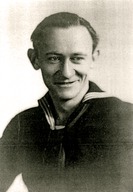
|

|
|
|
|
Sterling was born in Ansley, Louisiana, a sawmill town that no longer exists. He was one of two brothers and three sisters born to Sterling Joseph Spell and Elizabeth Eliza Droddy, whose family also worked in logging camps. His siblings were Jo Versel, Lucy V., Alweina Elizabeth, and Orville Ray. Another daughter died of spinal meningitis when she was eight months old. Sterling's father came to the area in 1915 as a hardwood sawyer, a man who operates the carriage at the hardwood wheel. Eventually, his father became general superintendent of the mill. Sterling grew up in a "company house" that belonged to the timber company and bought groceries at the commissary. The family also had cars, one of them a 1936 Ford in which Sterling learned to drive. The lumber town had a black and white school. "I grew up among black people and had black friends," he recalls. "It's strange how that works. Black and white kids played together until they reached a certain age. Then for some reason we were separated. We were always friends. We always had a good relationship with the black guys but they lived a different kind of life than we did." Sterling completed high school in Ansley in 1941 and was drafted in December of 1943 going on active duty in January of 1944. After boot camp in California, he was sent to Ayia Naval Air Station in Hawaii. Sterling sailed out on the USS Miami, a heavy cruiser to Eniwetok in the Marshall Islands. There he transferred to the USS Caswell, an attack cargo ship. Soon he was placed in a fire control unit and made Seaman 1st Class, with his combat station as a gun pointer in the main battery director. He was soon promoted to 3rd Class petty officer, the same pay grade as the army's "buck" sergeant. The Caswell, he recalls, participated in "every invasion of the Marshall Islands to Japan. We made them all: Okinawa, Iwo Jima, Chichi Jima." In the campaign for Okinawa the Caswell went on Radar Picket Station 15 for "five or six weeks at a time". Kamikazes, he recalled, "would come every day. You could see them out on the general horizon buzzing like bees and all of a sudden one would peel off and he'd come," he recalls. The Caswell also fired illuminating star shells (like flares) towards land so troops there could spot the enemy. Sterling fought on, even after "Harry dropped the two bombs and after that everything got quiet," he remarks. Japanese kamikaze planes still attacked American ships. "The war was over and we were not supposed to be doing that but they still were trying," he recalls. Then he adds, "The only reason we ever won that war is because of the two bombs; Nagasaki and Hiroshima". "It just killed so many people. They couldn't stand it." The Caswell sailed into Tokyo Bay as part of the invasion fleet. There he watched the surrender ceremony aboard the USS Missouri. Sterling went ashore and had pleasant experiences with the Japanese people. By February of 1946 the Caswell docked in Boston where it was de-commissioned. Sterling, the last fire control officer on board was discharged in New Orleans in 1946 and went home to Ansley, arriving on Easter. He enrolled at Northwestern State College in Natchitoches on the GI Bill, and stayed for two years before transferring to Louisiana Tech, where he graduated in 1950 with a Bachelor of Science in forestry. In August of 1953 he married Rebecca Emory. They would have two sons, Patrick and Joseph, and a stepson, Alvin. Rebecca passed away in 1998. A year later he married Linda Smith. Sterling worked many years for the Bolinger Company, a lumber enterprise that he eventually bought. |


